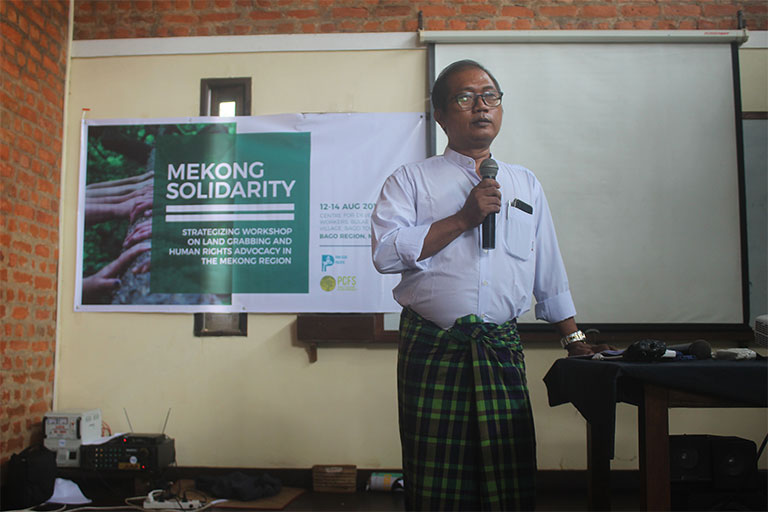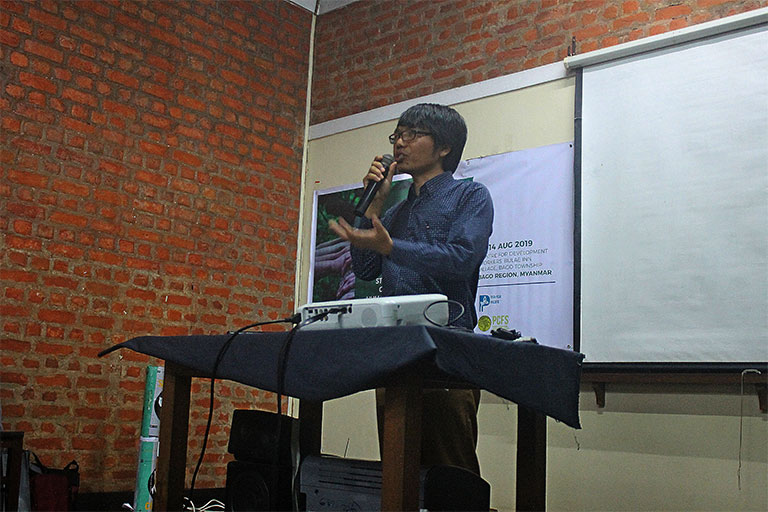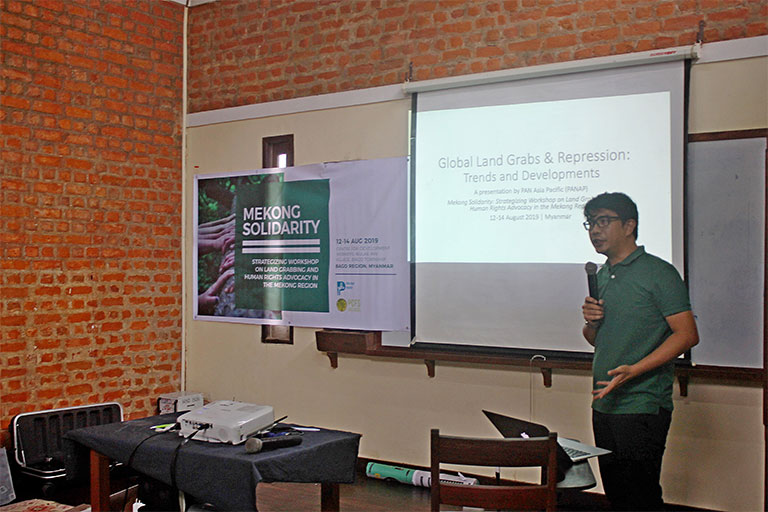Connected by Southeast Asia’s longest transboundary waterway, downstream Mekong countries likewise share a characteristic that is perhaps nowhere near as disputable as in other regions. The area serves not just as a global hotspot for transnational land deals, but also as a flashpoint for human rights violations brought on by intensified land conflicts and struggles — at the receiving end of which are rural people, farmers and farmworkers, indigenous peoples, and land activists.
These deals, often touted as development projects, have lately been ushered in through the Belt and Road Initiative (BRI), China’s multilateral initiative to finance and build infrastructure in more than 78 countries. It remains a lynchpin of China’s ambition of economic expansion by integrating into transport networks and intercontinental markets. Arguably, as the 21st century’s biggest overseas investment drive, the BRI has threatened large-scale land grabs in the Mekong where China crystallizes its geopolitical influence.
The emerging imperial power, however, represents but one of the many foreign interests keen on exerting pressure on rural communities in the Mekong region. Other transnational investments have also come in, facilitated by land policies like the new Vacant, Fallow, and Virgin (VFV) Land Law in Myanmar that snubs peasants’ customary land rights. Inextricable from incidents of displacement is the subsequent takeover of land by the government, mega-corporations, and state forces like the military.
Against this backdrop of repression, both at the local and regional levels, PAN Asia Pacific (PAN AP) has partnered with the People’s Coalition on Food Sovereignty (PCFS) to organize a three-day strategizing workshop from 12 to 14 August 2019, in Bago township (88 kilometers northeast of Yangon), Myanmar. Local partners Ethnic Concern and Farmer Affairs Network (FAN) helped coordinate with participants from civil society organizations (CSOs) in Myanmar and other peasant groups and NGOs that work on grassroots movements and land and human rights issues from Cambodia, Laos, Vietnam, and Thailand.
The workshop generally aimed to develop a preliminary plan for cooperation among the Mekong countries in addressing current and emerging concerns about land and resource grabbing in the sub-region. It had five specific objectives, to wit:
- To deepen the collective understanding of the current trends that impact on the access to and control of rural communities in the sub-region over their own land resources;
- To share updates on the state of land and resource grabbing, including related human rights violations, in the sub-region;
- To identify key pressure points and potential areas of collective and individual engagement at the regional and national level to oppose land and resource grabbing and related human rights violations in the sub-region;
- To identify a set of activities and initiatives that can be implemented collectively or individually at the regional or national level by the participating organizations; and
- To foster solidarity and cooperation among CSOs and grassroots movements in the sub-region under a common campaign to stop land and resource grabbing and to promote human rights.
Overview of the Economic and Political Context of Global Inequality
Around 20 delegates from various local CSOs and farmers’ and indigenous peoples’ groups in Myanmar welcomed participants who had flown in from their other Mekong neighbors. Myo Thant of FAN stressed in his introductory remarks the need to recognize the larger problem of land insecurity, aggravated by both foreign and domestic elite interests, that confronts all Mekong countries, notwithstanding the nuances of their struggles.

The colonial history of the region, after all, bears witness to the centuries-old practice of land grabbing. It is perhaps as old as when man discovered the notion of private property and has become a phenomenon felt most acutely by impoverished countries like those in the Mekong, said Arnold Padilla, programme coordinator of PANAP’s food sovereignty programme.
The quest for new sources of capital accumulation over the past decades has, however, led off an era of neoliberal globalization that amplified land grabbing in scale and scope. Besides the expropriation of land, resources like raw materials have been extracted to cater to international markets while shrinking local industries and to introduce foreign investors out to seize even more and vaster lands for profits. China, for one, has proven adept at flexing its industrial muscle to make headway with mega-projects overseas. The challenge for disadvantaged nations to work together on this issue becomes all the starker, said Padilla. Rahmat Ajiguna, internal vice chairperson of the Asian Peasant Coalition (APC), elaborated on this global perspective on land grabbing. He situated the global land crisis in the broader context of capitalism in its monopoly stage. The Global South to which the Mekong sub-region belongs has always serviced imperial powers with cheap labor markets and resource reservoirs. The onset of liberalized trade in the 1970s, alongside deregulation and privatization of industries, skewed this relationship even further. Economies in leading industrial nations suffer booms and busts, which export of capital via foreign investments could stabilize in the interim while only delaying recessions owing to the heightened crisis of overproduction.
This crisis assumes harsher manifestations in so-called developing countries: foreign debts soaring, level of unemployment surpassing historic highs, disparity between the rich and the poor widening so much that, according to nonprofit Oxfam International, just eight men own as much as half the world’s wealth.
The majority of the world’s poor, according to Ajiguna, lives in rural communities that big businesses eye for supposed development. In fact, he said, only 8% of the 26.7-million hectares of land grabbed by the private sector since 2008 are cultivated for food production while over 70% are utilized for agro-industrial purposes. Mergers and acquisitions of agribusinesses, such as between Monsanto-Bayer and Syngenta- ChemChina, exemplify the sort of concentration of capital in the hands of multinational corporations.
Other forms of foreign intervention — from wars and militarism to increasingly authoritarian regimes — aggravate the conditions that propel land and resource grabbing. Ajiguna called for a multi-sector alliance among similarly oppressed countries to counter assaults on people’s rights and sovereignty. He described the workshop as a timely venue to forge these unities. “The goal is to build a new system hinged on social justice, genuine agrarian reform and democracy, and just development without exploitation,” he said.
Exploitation and Landlessness in the Mekong Sub-region
Should an international agrarian movement be built, the Mekong sub-region could be considered one of its epicenters. Dubbed Asia’s “rice bowl,” the riparian region boasts of rich biodiversity and agricultural produce on which many Southeast Asians depend. Fertile farmlands in the Mekong delta nurture millions of rural households on the one hand, and attract commercial or industrial developers on the other.

Foreign companies bankroll most of these developments, said Jimmy Rezarboi of the Ethnic Concerns. In his situationer on the Mekong region, he cited some examples like the China-Laos railway and the Long Jiang Industrial Park in Vietnam, both of which are Chinese-funded. Meanwhile, 20% of the economic land concessions (ELCs) in the region are concentrated in Cambodia, where, according to recent estimates, investments by Chinese agricultural firms have already amounted to over USD2.0 billion.
Rezarboi identified companies based in South Korea and Australia as the major investors in the Mekong next to China. Even within the region, several investors have imposed significant presence in their fellow Mekong countries. For example, Thai and Japanese investors have entered into a joint venture on the Dawei Special Economic Zone (SEZ) and Deep Sea Port in Myanmar, which could be the largest of its kind in Asia upon completion. State acquiescence to these projects set forth their progress, said Rezarboi.
Amendments to current land laws and formulation of new ones become instrumental in corporate seizure of land. Removal of parliamentary hurdles set development plans afoot, as with the recent enactment of the VFV Land Law in Myanmar that criminalizes farmers who have failed to register for a land title in time. Rezarboi also mentioned how the institutionalization of urban planning efforts, such as the New City of Yangon, legitimizes either land use conversion or massive land concessions. At any rate, astonishingly large-scale, state-backed developments justify otherwise illegal ejection of residents from their villages.
Yet links between government officials and agribusiness owners or operators follow a pattern common to most Mekong countries. Their governments have lately leaned more authoritarian and shown overtures to repressive policies. Though some are nominally parliamentary in nature, such as Cambodia and Myanmar, leaders with conflicts of interests hold key posts and pledge commitments to mostly bilateral economic partnerships. Rezarboi lamented the gross rights violations these foreign incursions often cause at home.
The management of said projects falls on the government, which serves to reproduce the socio-economic impacts on the ground. “The role of civil society, land rights defenders, and many other groups should be to counter efforts at dispossession by companies as facilitated by the government,” Rezarboi added.
Global Land Grabs amid Repression of People’s Rights
Peasant and indigenous communities are the biggest losers when land grabs take place, for they witness the vaunted promise of economic prosperity, which these developments supposedly bring forth, slip their grasp amid decades of neo-colonialism and globalization. Worryingly, the state of landlessness worldwide is bound to worsen, said Padilla of PANAP in his discussion on land grabbing trends and developments.
He began his presentation by contrasting the corporate regime of food production with the agroecology- based farming approaches and knowledge systems that many CSOs and progressive groups present as an alternative. Food sovereignty, after all, cannot be divorced from the campaign against land grabs and the promotion of the people’s rights to economic security and stewardship of their own resources.


Towards this PANAP has launched the No Land, No Life! campaign, among whose aims is to highlight and coordinate specific struggles of local communities versus land and resource grabs. Padilla commended the strong and vibrant peasant movements particularly in the Mekong region, and said the workshop that PANAP had co-organized sought to reinforce their various programs at the regional or international level.
These campaigns amount to a repudiation, not only of forces spurning genuine agrarian development, but of extreme poverty which different forms of land and resource grabbing inevitably drive. “If you analyze it, the poor are poor because they don’t have adequate access to livelihood,” Padilla said, “and in the rural areas, land is the primary source of one’s livelihood.”
He said that even residents in the slum zones, who most everyone thinks of right away when talking about poverty, have only been compelled to migrate because of the dismal income prospects in the countryside. The bulk of the rural population comprises the multidimensionally poor, or those that not only suffer paltry wages but also lack sufficient access to livelihood and basic utilities. They stretch across most of what multilateral financial institutions call developing nations — the same ones where contracts and collusions between governments and businesses pave the way for land deals, said Padilla.
As of May 2019, data from the Land Matrix totaled 2,308 land deals spanning approximately 82 million hectares of land, and over 10% of this global total transnationally cover lands in low- and middle-income countries in Asia. They deliberately and radically transform these landscapes more than just transferring the rights of use, control and ownership of land by virtue of concessions, leases, or outright purchases. Tracts traditionally tilled for smallholder production, ecosystem service provision, or conservation efforts, as in the case of indigenous territories, undergo conversion for commercial purposes under these deals.
In the Mekong, transnational and domestic land deals — 169 in Cambodia, 117 in Myanmar, 94 in Laos, 42 in Myanmar, and 5 in Thailand, according to the latest data from the Land Matrix — have been concluded, yet still require, on the ground, detailed determination of their extent and impact. Only few of these have to do with the food sector while most are industrial and export-oriented, such as mining and logging.
Investors brokering these deals mainly come from the United States and Canada, but in Asia, it is China that gobbles up expanses of land to supercharge its bid for domination against other booming capitalist economies. It has expressed aggression in pushing for the BRI, erecting economic corridors, belts, and silkroads in strategic regional centers like the Mekong. In agriculture alone, said Padilla, Chinese-financed agricultural projects have spiked by 70% of their number five years ago. Some Chinese “senior agricultural experts” have also been deployed since 2014, who Padilla reckoned are positioned to assist in creating Chinese-controlled markets for their prospective products rather than just purportedly training locals.
Such investments merely provide some pretext for land grabs. At the level of policy, China similarly exerts influence, such as through the Regional Comprehensive Economic Partnership (RCEP), a proposed free trade agreement (FTA) among ten members of the Association of Southeast Asian Nation (ASEAN) and six other partners. Formally launched in 2012, it has now grown into the world’s biggest economic bloc.
Under the RCEP, pro-investor reforms and provisions on national treatment — that is, giving foreigners the same treatment as one’s own nationals — may flout restrictions on foreign land ownership, which remain in place in countries like Thailand. Padilla cited a standstill clause as another cause for concern, by which businesses can sue governments for failure to protect the former’s interests. Any reversal of laws that either guarantee liberalization or ease the entry of corporations may then constitute a breach of the RCEP.
All of these regulations sustain the global land grabbing trend while disproportionately disfavoring rural communities. Unsurprisingly, the Mekong countries party to such agreements and primed for land deals are also the hardest hit by violent attempts to subdue the resistance of land defenders.
Padilla told of difficulties in collating, let alone finding, available data regarding human rights violations in the Mekong. He conjectured, however, that there are bound to be multiple such cases that go unreported. If one were to go by the statistics on land-related struggles or disputes in Asia, based on PANAP’s latest monitoring, the police, military, and private security personnel reportedly perpetrate most of these violations. Padilla said the individual input of representatives from each Mekong country could hopefully flesh out this data and render a clearer picture of the issues stirring up rural distress in the sub-region.

#NoLandNoLife Features discuss recent developments, events, and trends on land and resource grabbing and related human rights issues in the region as well as the factors and forces that drive it. Send us your feedback at nolandnolife@panap.net.








Discussion about this post